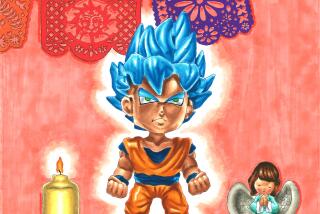A Worldwide Comic Book Success Story
- Share via
SAN DIEGO — Although her name is hardly a household word in America, Rumiko Takahashi ranks high among the world’s best-selling authors. The creator of the gender-bending “Ranma 1/2” and other popular manga (Japanese comic books/graphic novels), she has sold more than 100 million books worldwide and is reputed to be the richest woman in Japan.
Takahashi has acquired a steadily growing following among anime and manga fans in the United States since translations of her work began appearing 12 years ago. The audience response to her appearance at the recent San Diego comic book convention confirmed her popularity on both sides of the Pacific. Demand to attend her autograph session was so high that organizers wound up using a lottery system to determine admittance.
Speaking through an interpreter during a break at the convention, Takahashi said she was born in Nigata, Japan, in 1957 and always wanted to be a manga artist--although her parents were cool to the idea.
“I wouldn’t say they were completely against it, but they were concerned whether I could ever succeed as a manga artist,” she explained. “But now they’re very happy about it.”
Takahashi was only 21 when she created her first hit: “Urusei Yatsura” (known in the United States as “Lum-Urusei Yatsura”). Lum, a pretty and powerful alien girl, falls for the nerdy student Ataru and remains smitten with him through myriad slapstick adventures.
The 34-volume compilation of “Urusei Yatsura” sold more than 22 million copies and became the first of Takahashi’s manga to be adapted for animation. There have been six theatrical features based on it, a 197-episode TV series and direct-to-video adventures.
While she was drawing “Urusei Yatsura,” Takahashi scored another hit. In contrast to the zany adventures of Lum and Ataru, the manga “Maison Ikkoku” was a romantic soap opera with comic elements. Godai, a student, falls in love with Kyoko, the proprietress of the boarding house where he lives.
Shortly before they finally marry, Godai visits the grave of Kyoko’s first husband and asks the dead man for permission to marry his widow: “You’ve been a part of her since the first day I met her . . . and still I fell in love with her. So I’m taking you into my life, too. As part of her. You would be happy for me . . . wouldn’t you?”
These gentle feelings seem at odds with the stereotype of the impassive, work-obsessed executive, but Godai represents a new breed of Japanese male: An aspiring kindergarten teacher, he adores caring for children.
“That old-school view of what husbands should do is extinct, I think; among younger couples these days, there are more people like Godai,” Takahashi said. “I’m not fighting any kind of stereotype; it’s just an old concept as far as I’m concerned.”
Shortly after completing “Maison Ikkoku,” Takahashi began her most popular creation: “Ranma 1/2,” which ran from 1988 to 1996 in the weekly magazine Shonen Sunday and was reprinted in 38 volumes. The title character, whose name means “disorderly horse” in Chinese, is a wiry high school student and martial artist. When his father took him to a haunted spring in China, Ranma fell into an enchanted pool. As a result, whenever he’s splashed with cold water, he turns into a buxom, red-haired girl. His father was kicked into a different pool and turns into a panda when hit with cold water. A dash of warm water returns them to their proper forms.
Not surprisingly, Ranma’s transformations produce slapstick complications. In female form, Ranma competes in such unlikely activities as martial arts tea ceremony, survival flower-arranging and obstacle course cooking. The gender-switching also complicates his fractious relationship with his fiancee, Akane, a martial arts student who frequently beats her other admirers to a pulp.
“Ranma” has been made into two features, 161 broadcast TV episodes, several direct-to-video adventures and music videos. Japanese and American fans have created hundreds of “Ranma” Web sites and have bought countless “Ranma” T-shirts, wristwatches, baseball caps and other paraphernalia. Fifteen volumes of the manga (out of a projected total of 30) have appeared in English, and about 100 video installments of Ranma’s misadventures have been issued in dubbed and/or subtitled versions.
Asked to explain the popularity of this improbable comedy in the United States, Takahashi replied, “A lot of ‘Ranma’ involves slapstick and wacky situations; that kind of humor can cross borders. It’s very popular in America and in Asian countries other than Japan. Something funny isn’t restricted by borders.”
Despite her success, Takahashi maintains a grueling schedule, producing 100 manga pages each month--something no American comic artist would dream of attempting.
“In addition to the story and the dialogue, which I do myself, I draw all the characters in all the panels on all the pages,” she said. “My assistants work on the backgrounds, color in the black areas, erase the pencil marks, so I do most of the art.”
Takahashi is less involved with the animated versions of her work, although she corrects the model sheets of the characters and helps choose the voice actors. Asked about the differences between media, she said, “Animation and manga are two different products, and as long as people enjoy both of them, I think it’s fine.” With unfeigned modesty, she added, “I think manga is a very fun form of entertainment, and I’m really happy to know there are readers enjoying my books in America.”
More to Read
The biggest entertainment stories
Get our big stories about Hollywood, film, television, music, arts, culture and more right in your inbox as soon as they publish.
You may occasionally receive promotional content from the Los Angeles Times.










